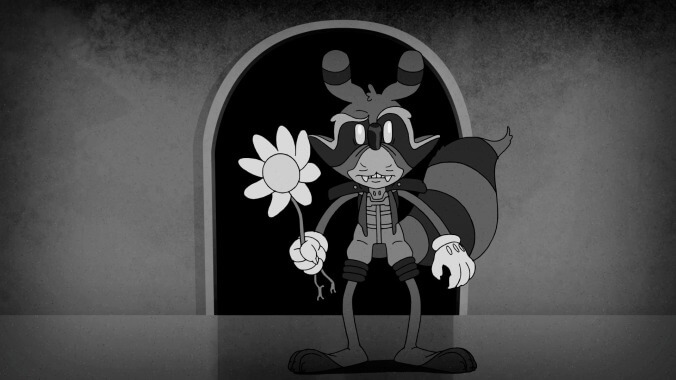Most of the recent animated TV offerings in Disney XD’s “Marvel Universe” bloc have contented themselves with being dependably entertaining, albeit unremarkable, children’s entertainment. (The first round of Marvel Rising: Initiation shorts were a welcome exception.) The wit and warmth of an Earth’s Mightiest Heroes or Spider-Man can stand out at times, but the actual animation rarely calls attention to itself. That changes with the new four-episode arc of Guardians Of The Galaxy: Mission Breakout! The show, now in its third season, has fashioned a storyline and accompanying change-up to its usual look that feels as fresh and inventive as James Gunn’s big-screen adaptation. The focus is still squarely on young viewers, but in the grand tradition of Tiny Toon Adventures or Animaniacs, the series is putting its normal brand of heroics on hold to indulge in a breezy and meta trip through the history of superhero animation.
The setup is (appropriately) cartoonishly simple: Having just completed their last mission but faced with a self-destruct countdown on their vessel, the Guardians use a mirror called the “Black Vortex” to escape, a gateway to an indestructible prison dimension. (No one’s excited about voluntarily entering an evil prison, but they’re out of options—and besides, as Rocket notes, “Ain’t a prison in the galaxy I can’t escape.”) Leaping through it, they find themselves separated, each one trapped in a different reality meant to distract them from finding one another and figuring out a way to break free.
In practice, what this means is an opportunity for the series to use each individual Guardians’ narrative as an excuse to radically transform the style of animation. Gamora wakes up in a low-budget version of a classic Disney princess aesthetic, complete with adorable talking animals and sing-along homilies to cleaning up the home. Drax finds himself in a strange urban landscape with a booming voice narrating his actions, which is gradually revealed to be a comic book aping the conventions of old-school Spider-Man, Superman, and more. Groot and Rocket each come to in three-dimensional CG landscapes—with the former even discovering that this reality allows him to communicate normally, with everyone else constrained by his usual “I am” utterance. And Peter Quill, a.k.a. Star-Lord, stumbles into a claymation universe in which his ship is on a collision course with a sun, leaving his newly pliable body vulnerable to melting.
Not content to limit themselves to one experiment per character, the show doubles down for its final two episodes of this story, and the results are arguably the best of all of them. Rocket escapes his CG nightmare only to stroll right into an old-school black-and-white Warner Bros. cartoon, complete with a Looney Tunes-esque chase sequence where he’s pursued by “Ronan The Exterminator.” Quill and Gamora, having found their way out of their previous prisons, team up for Quill’s childhood dream come true: embodying the avatars of an 8-bit arcade game.
The scripts change tones and styles in tandem with the aesthetics, and it results in genuinely funny moments, if not necessarily the deepest character studies. The guileless Drax being pitted against an unseen narrator makes for some genteel levity, such as the musclebound man complaining that a certain event being recounted never happened, only to be admonished, “Stop breaking the fourth wall!” He then starts tearing through the pages of the comic in which he’s trapped, passing by all-too-familiar comic book advertisements for x-ray specs, muscle milk, and more. The claymation sequence with Star-Lord is even better, throwing in Mr. Bill references and delivering a minutes-long homage to Evil Dead 2’s severed-hand bit.
Every episode starts exactly the same—with the prelude to passing through the mirror—meaning the episodes don’t even necessarily need to be watched in order to be appreciated (save for the final one, which resolves the situation and sends the heroes careening off to their next adventure). Not that the overarching plot matters tremendously: Mostly, this is an opportunity to see Rocket go racing off the edge of a cliff, Wile E. Coyote-style; to see Star-Lord make like a California Raisins music video; and to see Gamora forced to sweep the floors of a princess-dressed cabin while birds sing a jaunty song. The stylistic flourishes can sometimes be anachronistic—pretty sure there weren’t many 8-bit arcade games back in the day that allowed you to take a snapshot of a character to share later, as Quill does when Gamora is forced to don a frilly pink dress—but such quibbles are almost beside the point. The affection these episodes show for the animation techniques they reference is obvious and infectious. By the end, you’re ready to see what they can tackle next. Anime Groot, perhaps?


